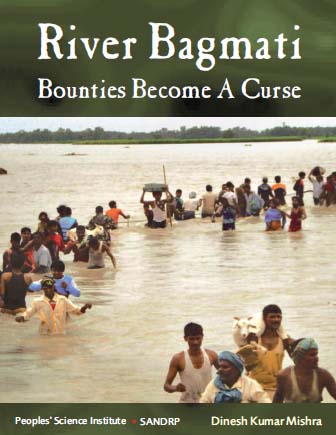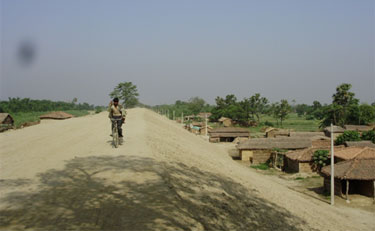Dinesh Kumar Mishra
Bihar's great walls of destruction
Posted on 07 May, 2014 10:49 PMBorn out of the sea, the Ganga basin is a playground of the rivers coming down from the Himalayas. Floods are not a new thing in Bihar, a state in the lap of these flood plains. For centuries, the people here have lived with these waters, with the floods washing away their lands once a year, slowly, leaving behind a blanket of rich and fertile silt.

River Bagmati: Bounties become a curse – A book by Dinesh Kumar Mishra
Posted on 14 Oct, 2012 05:20 PM
Resuscitating a failed idea - Notes from Bihar – A paper in Economic and Political Weekly
Posted on 07 May, 2012 11:36 AMThis article by Dinesh Kumar Mishra, Convenor of the Barh Mukti Abhiyan (movement for freedom from floods), Bihar in the Economic and Political Weekly states that the idea of a national interlinking of rivers needs to base itself on the past six decades’ experience of river and flood control measures.
Villages in north Bihar sinking in Bagmati's sand - Entire flood control planning needs thorough review - Article by Dinesh Kumar Mishra in d-sector.org
Posted on 16 Jun, 2011 03:56 PM The Bagmati Embankment separating riverside on the left and countryside of the right near Ibrahimpur – Electric poles suggest the height of the embankment
The Bagmati Embankment separating riverside on the left and countryside of the right near Ibrahimpur – Electric poles suggest the height of the embankment
One often hears about the civilizations buried under earth and attributes various reasons for such disappearance of life from a particular place. Excavations reveal the way of life the people might have had before they chose to leave their villages and towns and allowed the nature to take its own course. These accounts are available in books and we all believe the process told to us by historians and archaeologists. These are all conjectures that are revealed by scientific investigations but how many of us have seen, not read, how the civilizations get buried under the debris created by nature? There are places in Bihar where one can see the process of disappearance of civilization and the villages getting buried under the sediments brought by rivers.
Embankments related compensation to drain Indian exchequer : Need to review the flood control policy of the Government
Posted on 16 Dec, 2010 03:14 PMGovernment of Nepal has asked the Government of India to compensate its citizens badly affected by embankments and other flood control measures taken on river Gandak. Will this not lead to a flood of demands for compensation by the victims of similar problems in other river basins like the Bagmati, the Kamala and the Kosi?
Who cares about the public? A first hand report of the tensions prevailing around the Kosi in Nepal and Bihar
Posted on 04 Nov, 2008 10:12 PMThe setting is unique. 34 Nepali villages within the embankments want the breach to remain opened. I talked to some of them and reminded them of the slogan that was in air at the time of construction of the embankments, "Aadhi Roti Khayengein, Kosi Baandh Banayengei".
Of Deluge, Candles and Matchboxes
Posted on 24 Sep, 2008 11:26 PMGuest Post by: Dinesh Kumar Mishra
The foundation stone of the Kosi Project was laid on January 14, 1955 amidst fanfare, jubilation and victory. Dr. Shrikrishna Sinha, thgen Chief Minister of Bihar, laid the foundation stone near Bhutaha village close to Nirmali, in Saharsa (now Supaul) district with the chanting of mantras by Pt. Mahabir Jha of Jhitki village and shouting of slogans like 'Aadhi Roti Khayengein, Kosi Bandh Banaayengein.' (We will eat only half a chapati but we will surely build the Kosi embankments). A majority of people lost the other half of the bread too on the 18th August 2008 when the Kosi embankment breached on that day.
Col. Townsend of the US Army while deliberating in a seminar organized by the American Society of Civil Engineers to discuss the Mississippi floods of 1927 had said that even the best designed and carefully constructed embankments remain at the mercy of burrowing animals like rats, foxes, muskrats who can create a hole in the finest levee that has been devised, which if not closed within a few moments will ensure its destruction. The Mississippi River of the United States broke loose in 1927 inundating an area of 51,200 sq. kilometer and damaging property to an estimated extent of two hundred million to a billion dollars. The breaches drove nearly three quarters of a million people from their homes and six hundred thousand of them were dependant on Red Cross. The wealth and power of the United States enabled much to be done for the sufferers, still they suffered. He further added a 'careless supervisor and dark nights' to the list destroyers of embankments. His observations remain valid till date as the Kosi comes out of its shackles in Kusaha in Nepal some 13 kilometers upstream of the Kosi Barrage. All the eight breaches that have occurred so far can be brought under these categories.
Col. Townsend gave benefit of doubt to the planners and engineers when he prefixed 'best designed and carefully constructed' adjectives to the embankments. The Kosi has breached its embankment eighth time and it is for the first time that the 'disaster' has generated so much of interest. These embankments are spaced at an average distance of 9 to 10 kilometers below the barrage with a maximum width of 16 kilometres between Kisunipatti and Bhaptiahi and minimum width of nearly 3 kilometres at the barrage itself. The spacing of the embankments is only 8 kilometres at the tail end, between Baluaha Ghat and Ghonghepur. In Nepal portion the spacing between them is restricted to between 3 to 6 kilometers. Common sense suggests that the spacing between the embankments should increase as the river advances further as more and more streams join the river from western side. This simple common sense was kicked around when these embankments were constructed in late 1950s. There were 304 villages with a population of 192,000 (1951 census) going to be trapped between the embankments and each one of them was trying to be located outside the embankments. Later the embankments were extended and 380 villages of Bihar and 34 villages of Nepal came within them. Their current population is nearly 1.2 million. The village locations were fixed and it was the embankment on either side of the river that could be moved. So did it happen. Now the embankment alignment is a caricature of what it was designed, if there was any design.
"Bagmati Calling" : Dharna by villagers demanding rehabilitation
Posted on 16 Jan, 2008 08:58 AMThe Bagmati Calling : I am reporting from the south bank of the Bagmati near Benipur in Muzaffarpur district of Bihar.
Bihar floods 2007-A review of the relief work
Posted on 25 Nov, 2007 02:33 AMSri. Dinesh Kr. Mishra reviews the relief efforts following the severe flooding of Bihar earlier this year. We have several earlier blog posts regarding the floods: https://www.indiawaterportal.org/blog/index.php/category/bihar-floods/
There is good news from the relief front from Bihar this year and that is definitely a healthy sign for future. It is there because for many years in the past, the relief scene used to be chaotic and 2004 flood relief scandal was the logical end of the goings on in relief distribution. A slight change for the better is greeted with cheers from all quarters. Providing relief is a state subject and the Central Government helps the states in some ways in managing relief to the flood victims. Twelfth Finance Commission has revised the standards set for relief under Calamity Relief Fund (CRF) and recommended it to be effective from June this year (2007). It is intended to glance through the relief operations in Bihar in the backdrop of standards and recommendations set by the Government. Government of Bihar submitted a memorandum for assistance to the Central Government on 28th August 2007. By that time 9939 villages in 225 blocks of 20 districts with a population of 20.4 million was hit by floods. GoB anticipated that by the time the floods are over, some 25 million people would be hit by the current floods. Some 515 persons were killed in the floods (projected 600), 512,000 houses were destroyed (projected 6 lakhs) and standing crops over 16.4 lakh hectares was submerged till then. Besides, there was an extensive damage to National and State Highways, breaches in embankments, damage to health infrastructure, industries, fisheries, energy and cattle. GoB had put its losses at Rs 8000 Crores and requested the Government of India GoI for immediate help. Of the requested amount, over half the demand (Rs. 4,130 Crores) was from the Disaster Management Department (DMD) of the state to cover the costs of food assistance ( @ one quintal wheat/ rice for estimated 6 lakh families), house rebuilding grant, distribution of polythene sheets, emergency cooked food and deployment of helicopters etc. The other departments of the state have put their demands separately.